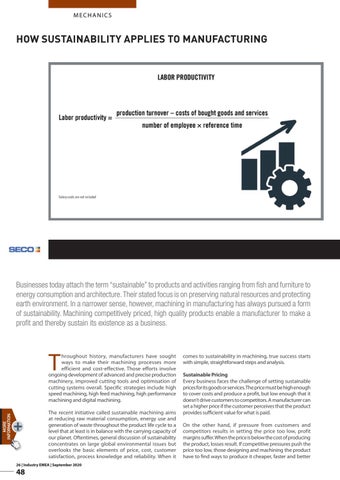MECHANICS
HOW SUSTAINABILITY APPLIES TO MANUFACTURING
Businesses today attach the term “sustainable� to products and activities ranging from fish and furniture to energy consumption and architecture. Their stated focus is on preserving natural resources and protecting earth environment. In a narrower sense, however, machining in manufacturing has always pursued a form of sustainability. Machining competitively priced, high quality products enable a manufacturer to make a profit and thereby sustain its existence as a business.
T
hroughout history, manufacturers have sought ways to make their machining processes more efficient and cost-effective. Those efforts involve ongoing development of advanced and precise production machinery, improved cutting tools and optimisation of cutting systems overall. Specific strategies include high speed machining, high feed machining, high performance machining and digital machining. MORE INFORMATION
The recent initiative called sustainable machining aims at reducing raw material consumption, energy use and generation of waste throughout the product life cycle to a level that at least is in balance with the carrying capacity of our planet. Oftentimes, general discussion of sustainability concentrates on large global environmental issues but overlooks the basic elements of price, cost, customer satisfaction, process knowledge and reliability. When it 26 | Industry EMEA | September 2020
48
comes to sustainability in machining, true success starts with simple, straightforward steps and analysis. Sustainable Pricing Every business faces the challenge of setting sustainable prices for its goods or services. The price must be high enough to cover costs and produce a profit, but low enough that it doesn’t drive customers to competitors. A manufacturer can set a higher price if the customer perceives that the product provides sufficient value for what is paid. On the other hand, if pressure from customers and competitors results in setting the price too low, profit margins suffer. When the price is below the cost of producing the product, losses result. If competitive pressures push the price too low, those designing and machining the product have to find ways to produce it cheaper, faster and better


































